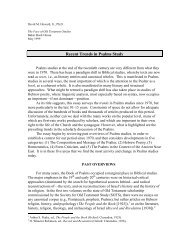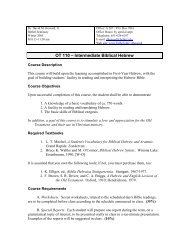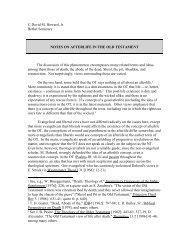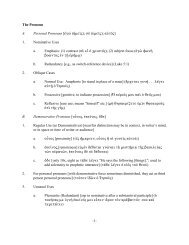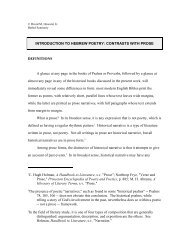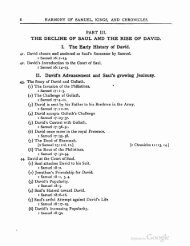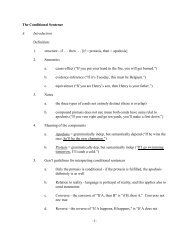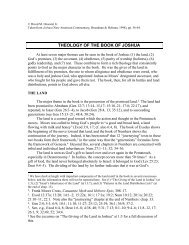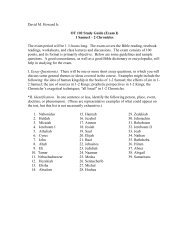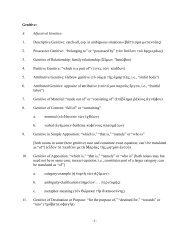Budget Constraints qStart to Build a Theory of Consumer Choice ...
Budget Constraints qStart to Build a Theory of Consumer Choice ...
Budget Constraints qStart to Build a Theory of Consumer Choice ...
You also want an ePaper? Increase the reach of your titles
YUMPU automatically turns print PDFs into web optimized ePapers that Google loves.
Microeconomics<br />
Dr. Dmitri M. Medvedovski<br />
<strong>Budget</strong> <strong>Constraints</strong><br />
●Start <strong>to</strong> <strong>Build</strong> a <strong>Theory</strong> <strong>of</strong> <strong>Consumer</strong> <strong>Choice</strong><br />
●Describe the Axioms <strong>of</strong> Human Behavior<br />
●Show how axioms map in<strong>to</strong> a concept called The Utility Function<br />
Axioms <strong>of</strong> Behavior<br />
●Insatiability<br />
–More is better<br />
●Continuity<br />
●even just a little bit more is better<br />
●Rationality<br />
–<strong>Consumer</strong> can judge and choose between options<br />
●Transitivity<br />
–If A is better than B and B is better than C, the consumer must prefer A <strong>to</strong> C<br />
Footnote On Arrow<br />
● Arrow has shown that it is impossible for a collection <strong>of</strong> individuals <strong>to</strong><br />
possess a representation that follows all <strong>of</strong> these axioms.<br />
●This is called the Impossibility Theorem<br />
●The most conspicuous culprit is transitivity<br />
The Representation Theorem<br />
●Given the axioms <strong>of</strong> behavior, there exists a utility function that represents<br />
the consumer’s tastes<br />
●This utility function is ordinal not cardinal<br />
●Like a thermometer, scale is irrelevant<br />
●Utility function is consistent <strong>to</strong> a mono<strong>to</strong>ne increasing transformation<br />
Review:<br />
. <strong>Consumer</strong> preferences<br />
. Indifference curves<br />
. Utility<br />
●Derive the <strong>Budget</strong> Constraint<br />
●Derive the Principles <strong>of</strong> Utility Maximization<br />
Page 1 out <strong>of</strong> 7 Lec. 5
Microeconomics<br />
Dr. Dmitri M. Medvedovski<br />
Principles <strong>of</strong> Optimization – Technical foundation for most problems<br />
in economics<br />
1. Definition <strong>of</strong> the objective function<br />
- utility function for consumers<br />
- production function for producers<br />
- pr<strong>of</strong>its<br />
- cost function<br />
2. Want either maximize or minimize the objective function. Your<br />
objective function must be well specified and conceptually<br />
measurable.<br />
3. <strong>Choice</strong> variables – they are imbedded in the objective function.<br />
Example: you have a consumer who is self interested with utility<br />
function that has numerous arguments as U=U(X1, X2,….Xn), the Xi<br />
are different things that make you happy. Start with things<br />
consumables from which you derive pleasure.<br />
4. Objective function has a goal.<br />
5. Be as large as possible (maximize your utility function)<br />
6. Introduce constraint<br />
7. Constrained optimization – optimization problems do not have <strong>to</strong> be<br />
constrained. However, the most interesting optimization problems in<br />
economics are constrained.<br />
- objective function<br />
- set <strong>of</strong> constraints (n-1 is the maximum number <strong>of</strong> constraints)<br />
- the optimizer chooses the levels <strong>of</strong> the choice variables.<br />
Assume a consumer picks Xi <strong>to</strong> maximize Utility.<br />
1) People have unlimited desires (wants) – which is not economics if<br />
there is no constraint.<br />
2) <strong>Budget</strong> constraint (Income is limited)<br />
M=I=P1X1+P2X2+P3X3+….PnXn (price times quantity that you<br />
choose) or M=∑<br />
n<br />
i=<br />
1<br />
P i<br />
X i<br />
3) Each consumer has idiosyncratic parameters such as:<br />
U=U(X1,X2…..Xn) is subject <strong>to</strong> constraint M=∑<br />
dU\dx is the marginal utility <strong>of</strong> the i-th good.<br />
n<br />
i=<br />
1<br />
P i<br />
X i<br />
Page 2 out <strong>of</strong> 7 Lec. 5
Microeconomics<br />
Dr. Dmitri M. Medvedovski<br />
U(X1, X2)<br />
X2<br />
U1<br />
U2<br />
X1<br />
It is impossible for indifference curves <strong>to</strong> cross each other because that<br />
would violate the axiom <strong>of</strong> transitivity. Prove follows.<br />
A<br />
C<br />
B<br />
One way <strong>to</strong> solve it is <strong>to</strong> use Mr. Lagrange<br />
n<br />
1<br />
, X<br />
2,<br />
X<br />
3...<br />
X<br />
n<br />
) + ( M −∑<br />
Pi<br />
X<br />
i<br />
)<br />
i=<br />
1<br />
L = U ( X<br />
λ<br />
Page 3 out <strong>of</strong> 7 Lec. 5
Microeconomics<br />
Dr. Dmitri M. Medvedovski<br />
The <strong>Consumer</strong>’s Problem<br />
●Attain the highest possible level <strong>of</strong> utility<br />
–Scale utility mountain<br />
●The available budget constitutes the constraint<br />
●Think <strong>of</strong> the budget as a fence on the mountain<br />
●Find the highest place on the fence<br />
The <strong>Budget</strong> Constraint<br />
●The consumer has a sum <strong>of</strong> money <strong>to</strong> spend each period, M<br />
This money is spread across many goods, X i<br />
●Thus the expenditure on the first good, X 1<br />
, is<br />
●And similarly for all other goods<br />
Graphical Construction <strong>of</strong> the <strong>Budget</strong> Constraint<br />
The <strong>Budget</strong> Line in Mathematical Terms<br />
●Imagine the consumer spends all income on good Y<br />
●The maximum amount <strong>of</strong> Y that can be purchased is M/(P Y<br />
)<br />
●If all income is spent on good X then the maximum quantity is M/(P X<br />
)<br />
●Join these two points <strong>to</strong> make a straight line<br />
●Any combination on the line exhausts the entire budget M<br />
The Slope <strong>of</strong> the <strong>Budget</strong> Constraint<br />
●The slope is the ratio <strong>of</strong> the two prices: derive: (M/Py)/(M/Px)<br />
●-P Y<br />
/P X<br />
The <strong>Consumer</strong> <strong>Choice</strong><br />
●Attain highest possible utility<br />
●Don’t violate the budget constraint<br />
●<br />
<strong>Budget</strong>: I = P 1 X 1 + P 2 X 2 , where X 1 and X 2 are goods.<br />
X 2<br />
50<br />
I<br />
P 2<br />
I<br />
P 1<br />
= X 1<br />
+ P 2<br />
P 1<br />
X 2<br />
40<br />
30<br />
20<br />
Slope = -1 = − P 2<br />
P 1<br />
I<br />
X 1<br />
= I P 1<br />
− P 2<br />
P 1<br />
X 2<br />
10<br />
10 20 30 40 50<br />
X 1<br />
P 1<br />
constant<br />
slope<br />
Page 4 out <strong>of</strong> 7 Lec. 5
Microeconomics<br />
Dr. Dmitri M. Medvedovski<br />
Comparative Static<br />
X 2<br />
I 2<br />
X 1<br />
I 1<br />
X 2<br />
X 1<br />
What happens if I (income) and prices triple at the same time (inflation)?<br />
X 1<br />
= 3I<br />
3P 1<br />
− 3P 2<br />
3P 1<br />
• X 2<br />
nothing changes<br />
X 1<br />
= I P 1<br />
− P 2<br />
P 1<br />
• X 2<br />
Given U (X 1 , X 2 , X 3 ,… X U ) X i represents the<br />
goods you want with your goal being <strong>to</strong><br />
maximize U within your budget constraint.<br />
I 1<br />
I 2<br />
I 3<br />
. I = money available, referred <strong>to</strong> as income.<br />
. Each good has a price; P i for good X i.<br />
N<br />
I = P 1 X 1 + P 2 X 2 +… ; E i = P i X i or ∑ xi p i<br />
=budget constraint<br />
i =1<br />
Lagrange (L)<br />
(L)=U(X 1<br />
, X 2<br />
, X 3<br />
… X u<br />
) − λ(I − P 1<br />
X 1<br />
− P 2<br />
X 2<br />
−…P i<br />
X i<br />
)<br />
. take derivatives with respect <strong>to</strong> each X i<br />
Page 5 out <strong>of</strong> 7 Lec. 5
Microeconomics<br />
Dr. Dmitri M. Medvedovski<br />
. they are partial derivatives because we do not let other variables ¨<br />
Why can’t indifference curves slope upward?<br />
By axiom “more preferred <strong>to</strong> less” we disprove upward sloping in difference<br />
curves.<br />
Y<br />
U 0 = U(Y 0 ,X 0 )<br />
U 1 = U(Y 0 ,2X 0 )<br />
U 1 > U 0 & U 1 = U 0<br />
Y 0<br />
X 0<br />
2X 0<br />
X<br />
Y<br />
Y 0<br />
Why can we not, as consumers, choose point<br />
A for consumption with the given budget<br />
constraint?<br />
X 0<br />
X<br />
What combination exhausts the opportunity <strong>to</strong> improve?<br />
Y<br />
I<br />
P y<br />
*what axiom does this indifference<br />
curve violate? Under what<br />
circumstances, if any,<br />
is this indifference curve possible?<br />
I<br />
X<br />
P x<br />
Page 6 out <strong>of</strong> 7 Lec. 5
Microeconomics<br />
Dr. Dmitri M. Medvedovski<br />
Y<br />
(hat)<br />
What does this say about Y? Does more X<br />
make us happier? Does this graph have any<br />
conflict with one <strong>of</strong> the axiom?<br />
X 1<br />
0<br />
X 1<br />
I<br />
X 1<br />
II<br />
X 1<br />
III<br />
X<br />
(right shoes)<br />
<strong>Consumer</strong> choice:<br />
. must be located on the budget constraint.<br />
. Must give consumer the most preferred combinations <strong>of</strong> goods and<br />
services.<br />
Y<br />
MRS= P 1<br />
P 2<br />
means satisfaction ∆X 2<br />
∆X 1<br />
is maximized, given budget constraint P 1<br />
P 2<br />
What does this say about X?<br />
X<br />
Page 7 out <strong>of</strong> 7 Lec. 5



